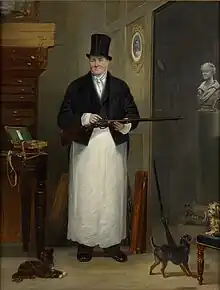
William Bishop (1797 – 16 March 1871) nicknamed as the Bishop of Bond Street was a gun dealer on New Bond Street, London, who served as an agent for the gunsmith Westley Richards. He was responsible for popularizing guns as a very successful gun seller and a promoter of sport shooting.
Biography

Bishop was born in Ealing and became a goldsmith and later served as an agent for Westley Richards. His shop which was at 170 Bond Street grew into a well-known establishment. Known for wearing a top hat indoors and for his charismatic manners he came to be called the "Bishop of Bond Street". George Teasdale-Buckell described him as: "A large and roomy man, old Bishop, sitting in front of the old white mantelpiece … his gouty leg up on a chair before him. Dressed from head to foot in the blackest of black, a huge white frill proceeding from his breast, and an enormous pair of shirt cuffs turned back over his coat sleeves, and a neatly brimmed hat, which no mortal eye had ever seen off his head. A truly right reverend and Episcopal figure.."[1] Bishop kept several pet dogs and when one of his dogs named Tiny was stolen he was angry to learn that a man could be jailed for stealing a dog collar but not a dog. He then helped create legislation to criminalize the theft of a dog and the Dog Act of 1845 came to be called the Bishop's Act.[2][3] He had a marble monument made when Tiny died. In 1861 the census noted him as a widower living with three servants above his shop. Upon his death, his estate was valued at £10,000.[4]
References
- ↑ Teasdale-Buckell, G. T. (1900). Experts on guns and shooting. London: Sampson Low, Marston, and Company. pp. 492–499.
- ↑ Tolfrey, Frederick (1845). "The Bishop and the dog bill". The Sporting Magazine. 6: 185–188.
- ↑ "Dog stealing Bill. (Hansard, 11 June 1845)". api.parliament.uk. Retrieved 2023-08-31.
- ↑ Taylor, Leslie B. (1913). A brief history of the Westley Richards firm, 1812-1913. Stratford-upon-Avon: Shakespeare head press. pp. 15–24.